Did you know that tomatoes are one of the most popular vegetables in home gardens across the United States? In fact, over 90% of American households grow tomatoes, making it one of the most widely cultivated crops in the country. Whether you’re a seasoned gardener or just getting started, using tomato clips can significantly improve the health of your tomato plants and ensure a successful harvest.
Key Takeaways:
- Tomatoes are a popular vegetable grown in over 90% of American households.
- Using tomato clips can enhance the health and productivity of tomato plants.
- A successful tomato garden requires proper care and maintenance.
- Tomato clips help support the growth of tomato plants and improve air circulation.
- By following the steps in this tomato clips guide, you can ensure a bountiful tomato harvest.
Proper Spacing and Planting in a Tomato Garden
Giving tomato plants enough room to grow is crucial for their health and productivity. The spacing and planting techniques will depend on the type of tomatoes and the support method you choose. Let’s dive into the details to help you establish a thriving tomato garden.
Spacing Tomato Plants
When it comes to spacing, you need to consider the variety of tomatoes you are growing and their growth habits. Indeterminate tomatoes, which continue to grow and produce throughout the season, are typically staked vertically. These plants require spacing of 18 to 24 inches apart to ensure proper airflow and sufficient sunlight exposure for each plant.
On the other hand, determinate tomato varieties are more compact and have a predetermined size and fruiting period. These plants are often bushy and do not require staking. To provide them with enough space for healthy growth, plant determinate tomatoes 24 inches apart.
Remember, adequate spacing allows each plant to receive the necessary nutrients, water, and sunlight without competing with neighboring plants. This promotes healthier plants, reduces the risk of diseases, and improves fruit quality and yield.
Planting Techniques
While spacing plays a significant role in tomato gardening, proper planting techniques also contribute to the success of your garden. Here’s how you can plant tomatoes for optimal growth:
- Choose a sunny location in your garden that receives at least 6 to 8 hours of direct sunlight per day.
- Prepare the soil by removing any weeds, rocks, or debris. Loosen the soil with a garden fork or tiller.
- Dig a hole that is slightly deeper than the root ball of the tomato seedling. This allows you to bury a portion of the stem to encourage the development of a strong root system.
- Place the seedling in the hole, ensuring that the top leaves are above the soil level.
- Gently backfill the hole with soil, patting it down firmly to eliminate any air pockets.
- Water the newly planted tomato seedling thoroughly to settle the soil around the roots.
By burying a portion of the stem, you allow the tomato plant to develop additional roots along the buried stem. This helps establish a more robust root system, enhancing nutrient uptake and overall plant health.
Now that you have learned about the importance of proper spacing and planting in a tomato garden, you are ready to create a favorable environment for your tomato plants to thrive. The next section will explore the essential steps for staking and supporting tomato plants to ensure they grow upright and produce abundant, healthy fruits.
Staking and Supporting Tomato Plants
When it comes to tomato plants, proper staking and support are essential for promoting healthy growth and maximizing fruit production. Determinate tomato varieties can be effectively supported using tomato cages, while indeterminate or vining tomatoes require a stronger and more versatile support system.
To provide sturdy support for indeterminate tomatoes, you can use tall stakes or DIY trellises. These structures allow the plants to grow vertically, saving space and improving air circulation in your garden. By training the plants to grow upward, you also reduce the risk of diseases caused by contact with the ground and maximize sunlight exposure, leading to better overall plant health and fruit quality.
When staking or trellising tomato plants, it’s crucial to secure the plants as they grow. This helps prevent damage from strong winds and heavy fruit clusters. One way to do this is by using twine or tomato clips to tie the main stem or branches to the support structure. Tomato clips are specially designed to hold the stems gently without causing any harm, providing reliable and long-lasting support for your plants.
By staking and supporting your tomato plants, you not only create a visually appealing garden but also ensure the plants’ health and maximize fruit production. Whether you choose tomato cages, tall stakes, or DIY trellises, don’t forget to use tomato clips or twine to secure your plants as they grow, keeping them upright and providing the support they need.
| Benefits of Staking and Supporting Tomato Plants |
|---|
| Promotes healthier growth: Staking and supporting tomato plants encourage vertical growth, allowing for better air circulation and reducing the risk of diseases. |
| Improves fruit production: By training tomato plants to grow vertically, you create an optimal environment for fruit development and increase overall yield. |
| Maximizes sunlight exposure: Vertical growth enhances sunlight penetration, ensuring that your tomato plants receive the necessary energy for photosynthesis and fruit ripening. |
| Reduces diseases: Keeping tomato plants off the ground minimizes the risk of diseases that can be caused by soil contact, such as fungal infections and rotting. |
Quote:
“Staking and supporting tomato plants not only provide them with the necessary structure, but also contribute to their overall health and productivity. By giving them the proper support they need, you’ll be rewarded with a bountiful harvest.” – [Gardener Name]
Mulching Tomatoes
Mulching is an essential practice for maintaining a healthy tomato garden. By applying a layer of organic mulch, you can provide numerous benefits to your tomato plants. Not only does mulching help suppress weeds, but it also aids in moisture retention and disease prevention.
There are two main types of mulch that are commonly used in tomato gardening: organic mulch and plastic mulch. Let’s explore the advantages of each:
Organic Mulch
Organic mulch, such as shredded leaves or straw, is a popular choice for many gardeners. It offers several benefits that contribute to the overall health of tomato plants:
- Reduces the spread of diseases: Organic mulch acts as a barrier between the soil and the lower leaves of the tomato plants, preventing soil-borne diseases from splashing onto the foliage.
- Retains soil moisture: By creating a protective layer on top of the soil, organic mulch helps prevent water evaporation, maintaining a consistent level of moisture in the root zone.
- Minimizes weed growth: Organic mulch inhibits weed germination and growth, reducing competition for nutrients and water.
“I always recommend using organic mulch in my tomato garden,” says Jane Thompson, an experienced gardener. “It not only helps keep the soil moist and cool during hot summer days but also provides a natural barrier against diseases.”
Plastic Mulch
Another option for mulching tomatoes is the use of plastic mulch, available in red or black varieties. Plastic mulch offers its own set of advantages and considerations:
- Enhances soil warmth: Plastic mulch absorbs and retains solar heat, creating a warmer environment for tomato plants. This can be particularly beneficial in cooler climates or during early planting.
- Controls weed growth: Similar to organic mulch, plastic mulch acts as a physical barrier that prevents weeds from sprouting and competing with tomato plants.
- Requires careful irrigation: Unlike organic mulch, plastic mulch doesn’t allow water to penetrate easily. As a result, irrigation must be carefully managed to ensure the plants receive sufficient moisture.
- Considerations for the environment: While plastic mulch offers certain benefits, it is important to consider its environmental impact. Plastic mulch is not biodegradable and can be detrimental to the ecosystem if not managed properly.
“In my experience, using plastic mulch can significantly increase tomato yields by maintaining optimal soil temperature,” advises Mike Evans, a seasoned tomato gardener. “However, I always make sure to use it responsibly and dispose of it properly after use.”
Mulching is an effective technique that can greatly benefit your tomato garden. Whether you choose organic mulch or plastic mulch, consider the specific needs of your plants and the environmental impact of your choice. Whichever option you go with, mulching will help create the ideal conditions for your tomato plants to thrive.
Watering Tomato Plants
Proper watering is essential for maintaining the health and vitality of tomato plants. Consistent and regular watering, especially during dry periods, is crucial to prevent common issues like blossom end rot. In this section, I will discuss the best practices for watering tomato plants to ensure optimal growth and productivity.
When it comes to watering tomato plants, it’s important to focus on the base of the plants rather than wetting the foliage. Watering the leaves can lead to increased disease susceptibility and hinder proper growth. Instead, direct the water at the root zone to provide efficient irrigation.
There are several methods you can use to water your tomato plants effectively. A watering wand or hose with a gentle spray nozzle can provide a controlled flow of water directly to the base of each plant. Another option is using a soaker hose, which delivers a slow and even supply of water to the soil, promoting deep root growth and reducing water waste through evaporation.
Remember to monitor the moisture levels in the soil to ensure you are providing adequate water without overwatering. Stick your finger about an inch into the soil, and if it feels dry, it’s time to water. Aim to moisten the soil to a depth of 6 to 8 inches.
Benefits of Proper Watering
Proper watering practices offer several benefits for tomato plants:
- Prevents blossom end rot: Blossom end rot, characterized by black, sunken areas on the bottom of tomato fruits, is often caused by inconsistent watering. Ensuring consistent moisture levels helps prevent this common problem.
- Encourages deep root growth: Watering at the base of the plants encourages the roots to grow deeper into the soil, promoting stability and nutrient uptake.
- Minimizes disease susceptibility: By avoiding foliage wetting, you can reduce the risk of fungal diseases, such as blight, which thrive in moist conditions.
- Promotes efficient water usage: Directing water to the root zone instead of spraying the entire plant minimizes water waste through evaporation and runoff.
Watering Schedule
Establishing a watering schedule is crucial to ensure your tomato plants receive the right amount of water. While the frequency may vary depending on factors like temperature and rainfall, a general guideline is to water deeply once or twice a week, providing enough water to penetrate the root zone.
“Consistent and regular watering is key to maintaining healthy tomato plants and preventing water-related issues like blossom end rot.” – Gardening expert
Keep in mind that the watering needs may change as your tomato plants grow. Young transplants and newly planted seedlings may require more frequent watering initially to help their roots establish. Additionally, be mindful of weather conditions, as hot and dry periods may necessitate more frequent watering.
Watering Methods for Tomato Plants
| Watering Method | Description |
|---|---|
| Watering wand or hose | A handheld device with a gentle spray nozzle for precise watering at the base of plants. |
| Soaker hose | A porous hose that delivers water directly to the soil, promoting deep root growth. |
Ensuring that your tomato plants receive adequate water is crucial for their overall health and productivity. By following the proper watering techniques and using suitable irrigation methods, you can provide the optimal moisture levels for successful tomato growth.
Fertilizing Your Tomato Garden
As a tomato gardener, I understand the importance of providing my plants with the nutrients they need to thrive. Tomato plants are heavy feeders and require regular fertilization to ensure optimal growth and a bountiful harvest. In this section, I’ll share some effective methods for fertilizing your tomato garden and keeping your plants healthy and productive.
One of the best ways to fertilize your tomato garden is by adding compost or aged manure to the soil before planting. This will provide a steady supply of nutrients to your plants and improve the overall soil quality. Compost is rich in organic matter and beneficial microorganisms that promote healthy root development and enhance the soil’s ability to retain water.
During the growing season, it’s also helpful to supplement the soil with additional tomato fertilizers. Slow-release organic fertilizers specially formulated for tomatoes can provide a steady release of nutrients over time, ensuring that your plants have access to the essential elements they need. These fertilizers are typically applied according to the package instructions and can be incorporated into the soil or sprinkled around the base of the plants.
Another option is to use liquid organic fertilizers like fish emulsion or liquid kelp. These concentrated fertilizers can be mixed with water and applied directly to the plants, providing a quick boost of nutrients. Liquid fertilizers are especially beneficial during periods of rapid growth or fruit development when plants require additional nourishment.
Tomato Fertilizer Comparison:
| Fertilizer Type | Advantages | Disadvantages |
|---|---|---|
| Compost or Aged Manure | Improves soil quality Provides slow-release nutrients Enhances water retention |
Requires pre-planting application May take time to decompose |
| Slow-Release Organic Fertilizers | Provides long-lasting nutrients Easy to apply |
May require multiple applications Can be more expensive |
| Liquid Organic Fertilizers | Quick nutrient boost Easy and convenient to use |
May require frequent applications Can be less cost-effective |
Remember to always follow the instructions on the fertilizer packaging and avoid over-fertilizing, as this can lead to nutrient imbalances or plant burn. It’s important to strike a balance and provide your tomato plants with the right amount of nutrients to support their growth.
In the next section, I’ll discuss the importance of monitoring your tomato garden for pests and diseases to ensure the health and vitality of your plants.
Monitoring for Pests and Diseases
Regular inspection of tomato plants is crucial for maintaining a healthy tomato garden. By keeping a close eye on your plants, you can identify and address pest and disease problems early on, preventing them from spreading and causing significant damage.
Here are some essential tips for monitoring your tomato garden:
1. Tying plants to supports
As your tomato plants grow, it’s essential to provide them with proper support. Tying the plants to stakes or using tomato cages keeps them upright and prevents branches from breaking under the weight of heavy fruit. Additionally, supporting the plants allows for better air circulation, reducing the risk of disease.
2. Removing bottom leaves
Tomato plants tend to develop fungal diseases, such as early blight, from contact with the soil. To prevent the spread of these diseases, remove the lower leaves that come into contact with the ground. This helps improve air circulation and reduces the likelihood of diseases taking hold.
3. Observing for signs of diseases
Regularly inspect your tomato plants for signs of diseases such as yellowing leaves, curling, or brown spots. Promptly identify and take action against any potential problems to prevent the diseases from spreading to other parts of the plant or neighboring plants.
“Regular monitoring of tomato plants is essential in order to catch pest and disease issues early. By doing so, you can minimize the impact on your crop and take appropriate steps to mitigate the problem.” – [Expert Name], Tomato Gardening Specialist
Another crucial aspect of managing pests and diseases in your tomato garden is implementing preventative measures:
4. Crop rotation
Rotate your tomato plants with non-solanaceous crops, such as beans or lettuce, every year. This helps break the life cycle of pests and reduces the risk of diseases building up in the soil.
5. Using disease-resistant varieties
Choose tomato varieties that are resistant to common diseases prevalent in your area. Disease-resistant varieties have built-in genetic traits that make them more tolerant to specific pests or diseases, providing an added layer of protection for your plants.
6. Practicing good plant hygiene
Regularly clean up fallen leaves and old plant debris to minimize the presence of overwintering pests and diseases. Proper sanitation practices, such as removing and disposing of diseased plants, help prevent the spread of infections to healthy plants.
By diligently monitoring your tomato plants and implementing these pest and disease management strategies, you can maintain a healthy tomato garden and increase your chances of a successful harvest.
| Pest | Prevention and Control |
|---|---|
| Aphids | Remove aphids by spraying plants with a jet of water or using organic insecticidal soap. Attract beneficial insects like ladybugs that feed on aphids. |
| Hornworms | Handpick and destroy hornworms. Encourage natural predators like parasitic wasps and birds. |
| Early Blight | Prevent early blight by spacing plants adequately, providing good air circulation, and avoiding overhead watering. Apply copper-based fungicides preventatively. |
| Tomato Mosaic Virus | Plant disease-resistant tomato varieties. Avoid handling tobacco products while tending to tomato plants as tobacco can transmit the virus. |
Trellising and Pruning Tomato Plants
Supporting tomato plants and promoting good air circulation are essential for their health and productivity. Trellising and pruning are key techniques that I use in my garden to achieve these goals. Let me share with you my tips and recommendations.
Tomato Cages for Determinate Varieties
For determinate tomato varieties, I highly recommend using tomato cages. These wire cages provide sturdy support, ensuring that the plants stay upright and preventing sprawling. Tomato cages are widely available at garden centers or can be easily made at home using wire mesh or fencing.
| Tomato Cage | Price | Material |
|---|---|---|
| Heavy-Duty Tomato Cage | $9.99 | Galvanized steel |
| DIY Tomato Cage | $0.00 (using wire mesh) | Wire mesh |
Trellising Indeterminate Tomatoes
Indeterminate tomatoes, also known as vining tomatoes, require a different approach. These plants have a sprawling growth habit and can reach impressive heights. Trellising is an excellent method to support their upward growth.
There are several trellising options that I recommend:
- Single Posts: Install sturdy posts at each end of the tomato row, spaced about 5 feet apart. As the tomato plants grow, tie them loosely to the posts using soft twine or tomato tape. This method provides vertical support and keeps the plants organized.
- Basketweave System: The basketweave system involves setting up pairs of stakes on either side of the tomato row and weaving twine horizontally between them. As the plants grow, gently guide the stems along the twine, creating a structured trellis.
- Combination Approach: For robust support, you can employ a combination of methods. Use single posts for initial support and secure the side branches to the twine in a basketweave pattern. This method provides both vertical and horizontal stability.
Pruning for Better Fruit Production
Pruning is an important practice that focuses the plant’s energy on fruit production and enhances air circulation, reducing the risk of diseases. Regular pruning helps maintain a tidy and productive tomato garden.
Here’s how I prune my tomato plants:
- Remove Suckers: Suckers are the small shoots that emerge in the leaf axils of tomato plants. By pinching them off, the plant’s energy is directed towards producing fruits instead of extra foliage.
- Remove Bottom Leaves: Removing the lower leaves of tomato plants helps prevent soil-borne diseases from splashing onto the foliage and reduces the risk of fungal infections.
Remember, pruning should be done selectively and not excessively. It’s essential to strike a balance to ensure proper foliage for photosynthesis and protect beneficial insects.
Trellising and pruning are valuable techniques that contribute to the overall health and productivity of tomato plants. By providing support and promoting good air circulation, you’ll be on your way to a successful tomato garden.
The Benefits of Vertical Tomato Growing
Growing tomatoes vertically offers several benefits. Vertical gardening improves air circulation, reduces diseases, and maximizes sunlight exposure for healthier plants and higher quality fruit. It also saves space and makes harvesting easier.
When you grow tomato plants vertically, you take advantage of vertical space, making it possible to grow more plants in a smaller area. This is especially beneficial for urban gardeners or those with limited garden space. By training the plants to grow upwards using trellises, stakes, or cages, you can optimize your garden’s productivity and yield.
One of the major advantages of vertical gardening is improved air circulation. When tomato plants are grown vertically, there is a natural flow of air around the foliage and fruit. This helps to prevent the stagnation of moisture, reducing the risk of fungal diseases such as blight, mold, and rot. With better air circulation, your tomato plants will stay healthier and produce higher quality fruit.
Maximizing sunlight exposure is another key benefit of vertical tomato growing. When tomato plants are grown vertically, all sides of the plants receive equal amounts of sunlight. This allows for uniform ripening and ensures that each tomato receives adequate sunlight for optimal growth and flavor development. By providing sufficient sunlight exposure, you’ll enjoy tastier and more delicious tomatoes.
Vertical gardening improves air circulation, reduces diseases, and maximizes sunlight exposure for healthier plants and higher quality fruit.
Furthermore, vertical gardening makes it easier to care for and harvest your tomato plants. With the plants growing vertically, you have better access to the foliage and fruit, which makes pruning, fertilizing, and inspecting for pests or diseases more convenient. Additionally, when it comes time to harvest, you won’t have to search through tangled vines or bend over as much, saving your back and knees.
Overall, vertical tomato growing is a practical and effective method that offers numerous advantages. The improved air circulation, maximized sunlight exposure, space-saving benefits, and ease of maintenance and harvest make it an excellent choice for gardeners of all levels of experience.
| Benefits of Vertical Tomato Growing: |
|---|
| Improved air circulation |
| Reduced risk of diseases |
| Maximized sunlight exposure |
| Space-saving |
| Easier maintenance and harvest |
Tips for Pruning Tomato Plants
Pruning tomato plants plays a crucial role in managing their growth and optimizing fruit production. By redirecting the plant’s energy towards the main stem, proper pruning ensures stronger and more abundant tomatoes. One important pruning technique is removing the suckers that form in the axils of leaves.
“Pruning tomato plants helps redirect energy into the main stem and fruit production.”
Suckers are the small shoots that emerge between the main stem and branches. They compete for the plant’s resources and reduce its overall productivity. To maintain a single-stem structure, I recommend pinching out these suckers regularly. This involves gently snapping off the suckers when they are small and easy to remove.
Note: Some gardeners prefer to leave one or two suckers intact to create a bushier tomato plant.
Regular pruning not only maintains the plant’s shape but also allows for better air circulation and sunlight penetration, reducing the risk of diseases. By removing excess foliage, the plant’s energy is focused on developing bigger and tastier tomatoes.
“Regular pruning encourages earlier, larger, and tastier tomatoes.”
| Benefits of Pruning Tomatoes | Pruning Techniques |
|---|---|
| 1. Increased fruit production | 1. Pinch off suckers growing in the leaf axils |
| 2. Larger and tastier tomatoes | 2. Maintain a single-stem structure |
| 3. Better air circulation and sunlight exposure | 3. Remove excess foliage |
Note: Pruning should be done once a week or as needed, depending on the growth rate of the tomato plants.
Pruning tomato plants requires careful consideration and observation. Each plant may have different needs, and factors such as variety, growth stage, and growing conditions can influence the pruning techniques used. Always monitor the plant’s growth and adjust your pruning strategy accordingly.
By following these tips for pruning tomato plants, you’ll be on your way to a healthier, more productive tomato garden with earlier, larger, and tastier tomatoes.
Identifying and Preventing Tomato Problems
To maintain healthy tomato plants, it’s important to watch for common problems. By following good plant hygiene practices, you can prevent the spread of diseases and ensure the vitality of your tomatoes. Remove yellow leaves and pick off overripe or diseased fruit to safeguard your plants. You can also take proactive measures such as crop rotation, proper spacing, and choosing disease-resistant varieties to minimize the risk of tomato problems.
“Good plant hygiene is essential in preventing diseases from taking hold in your tomato garden.”
Plant hygiene plays a crucial role in disease prevention. By removing yellow leaves and promptly disposing of them, you reduce the risk of pathogens spreading to healthy parts of the plant.
- Regularly inspect your tomato plants for any signs of disease, such as spots, discoloration, or wilting.
- Use sharp, clean gardening tools to avoid introducing pathogens into healthy plants.
- Properly disinfect tools with a solution of bleach and water between uses.
“Take steps to protect your tomato plants from common diseases through careful crop rotation and spacing.”
To prevent the recurrence of diseases and maintain plant health, it’s crucial to practice crop rotation. Avoid planting tomatoes in the same spot year after year. Rotate them with other non-solanaceous crops like beans, lettuce, and onions. This helps disrupt disease cycles and limits the buildup of pathogens in the soil. Adequate spacing between plants also allows for better airflow and reduces the risk of disease spread.
“Choose disease-resistant tomato varieties for a healthier and more productive garden.”
When selecting tomato varieties, prioritize disease resistance. Look for labels indicating resistance to common tomato diseases such as blight, fusarium wilt, and verticillium wilt. Disease-resistant varieties are bred to withstand specific pathogens, providing an added layer of protection for your plants.
“Prevent the transmission of tomato mosaic virus through careful practices and avoiding contact with tobacco.”
Tomato mosaic virus is a serious and highly contagious disease that affects tomato plants. It can be transmitted through touch, so it’s important to avoid contact with tobacco products when handling your plants. Additionally, practicing clean pruning techniques, such as disinfecting tools between plants, can help prevent the spread of the virus.
By being vigilant about plant hygiene, practicing preventive measures, and choosing disease-resistant varieties, you can minimize the risk of tomato problems and ensure the health and productivity of your tomato garden.
Conclusion
By following these tomato gardening tips, you can create a successful tomato garden and enjoy a bountiful harvest. The key to a thriving tomato garden lies in proper spacing and planting, staking and supporting, mulching, watering, fertilizing, monitoring for pests and diseases, trellising and pruning, and maintaining good plant hygiene.
Proper spacing and planting ensure that your tomato plants have enough room to grow and establish a strong root system. Staking and supporting the plants promote healthier growth and maximize sunlight exposure, leading to better fruit production. Mulching helps retain soil moisture, minimize weed growth, and reduce the spread of diseases.
Watering the tomato plants consistently, using proper watering techniques, helps prevent issues like blossom end rot. Providing the right nutrients through fertilization, using organic options like compost and tomato fertilizers, ensures optimal growth and a plentiful harvest. Regularly monitoring for pests and diseases, practicing good plant hygiene, and selecting disease-resistant varieties contribute to maintaining a healthy tomato garden.
Remember to trellis and prune your tomato plants to support their growth and improve air circulation. Vertical gardening offers added benefits, including space-saving and easier harvesting. With these tomato gardening tips, you’ll be on your way to a successful tomato garden and a delicious harvest. Happy gardening!

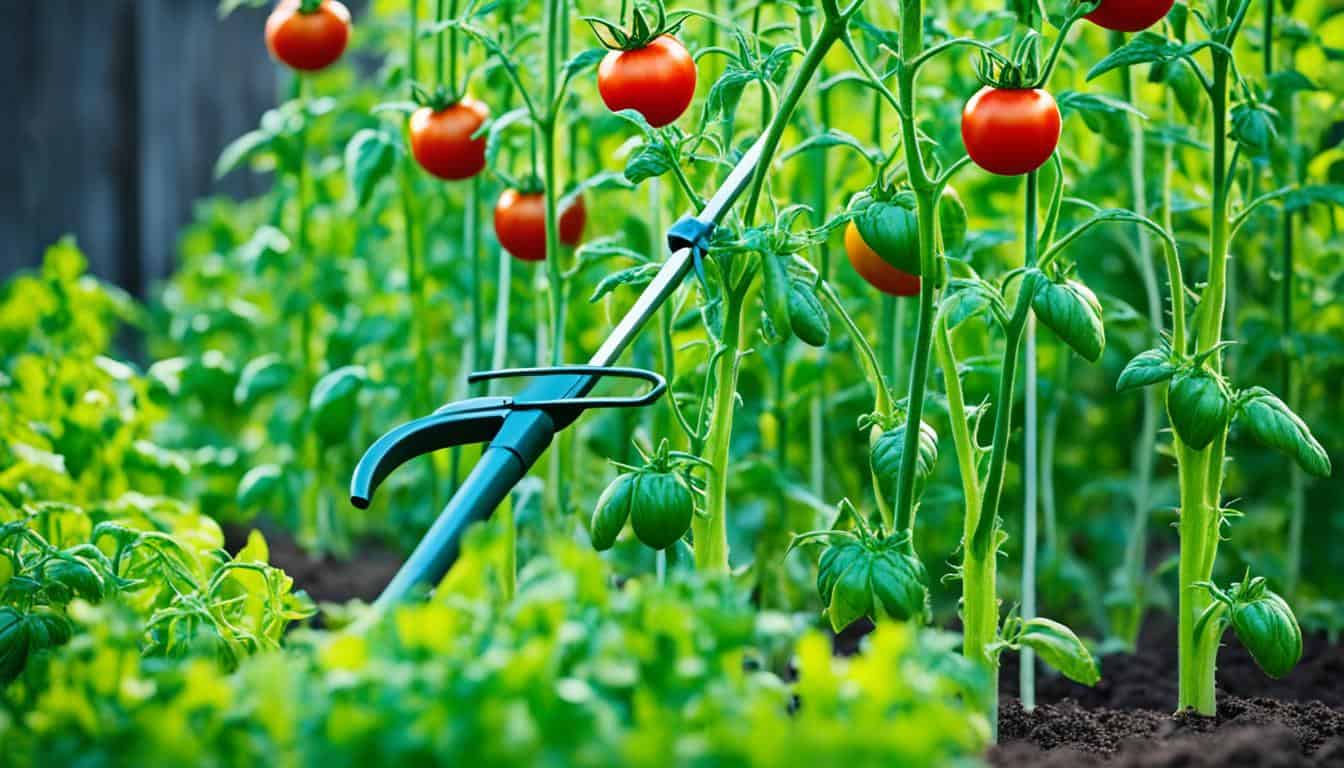
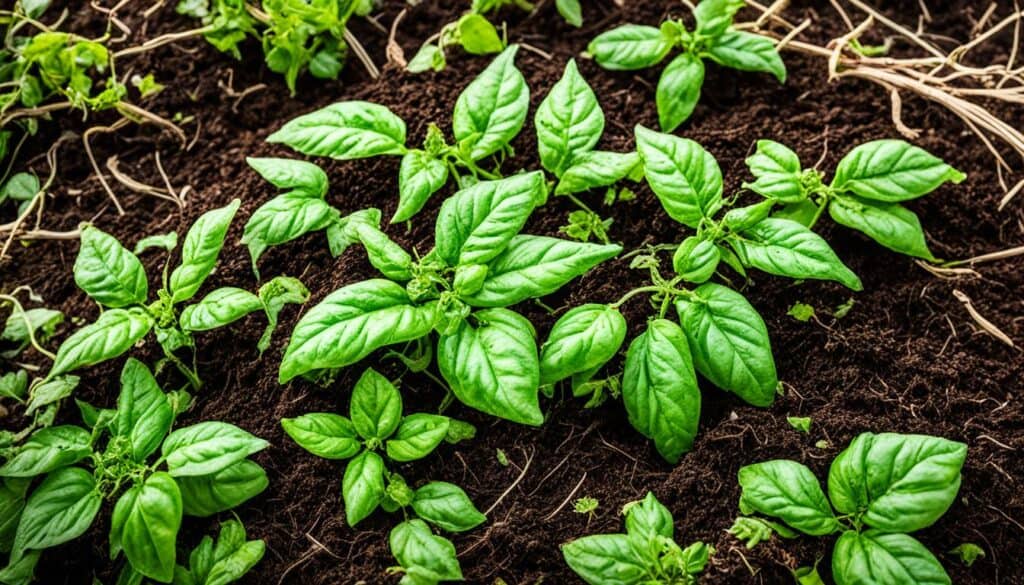
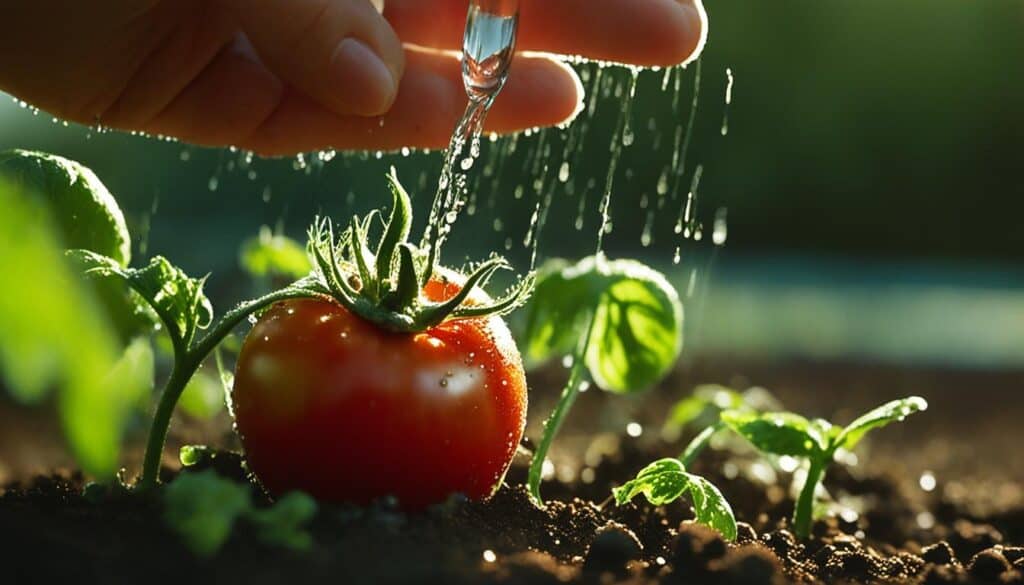
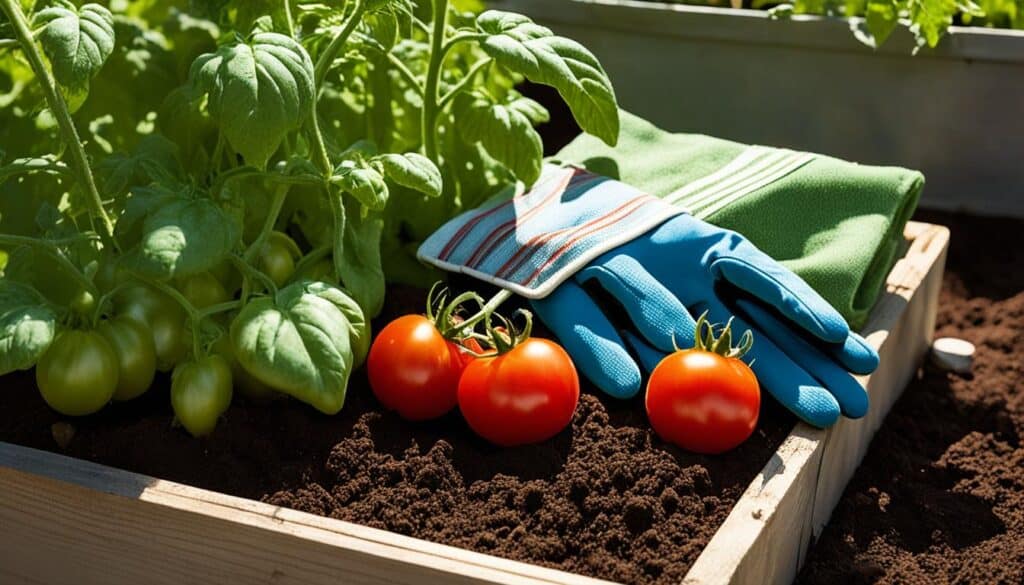
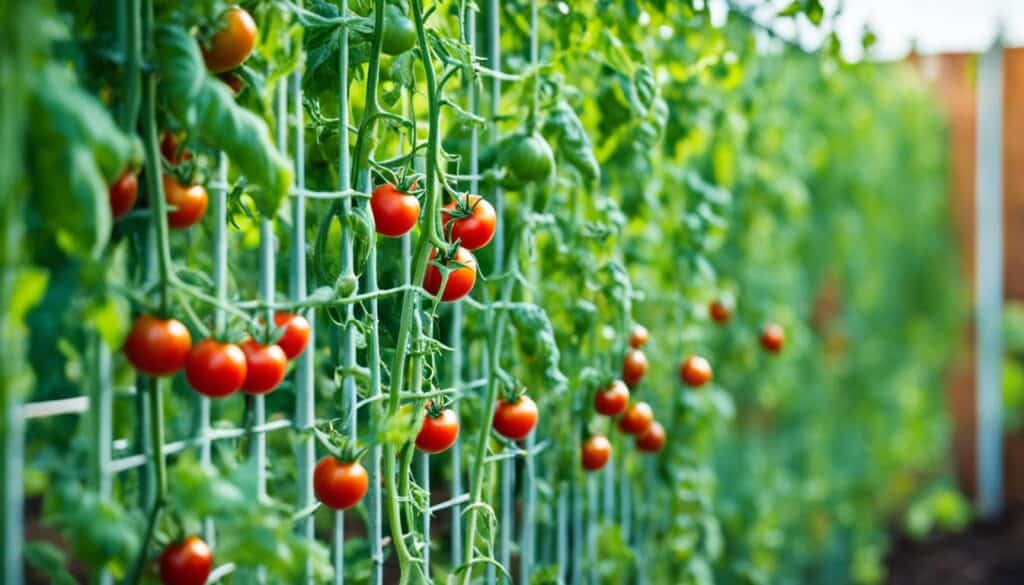
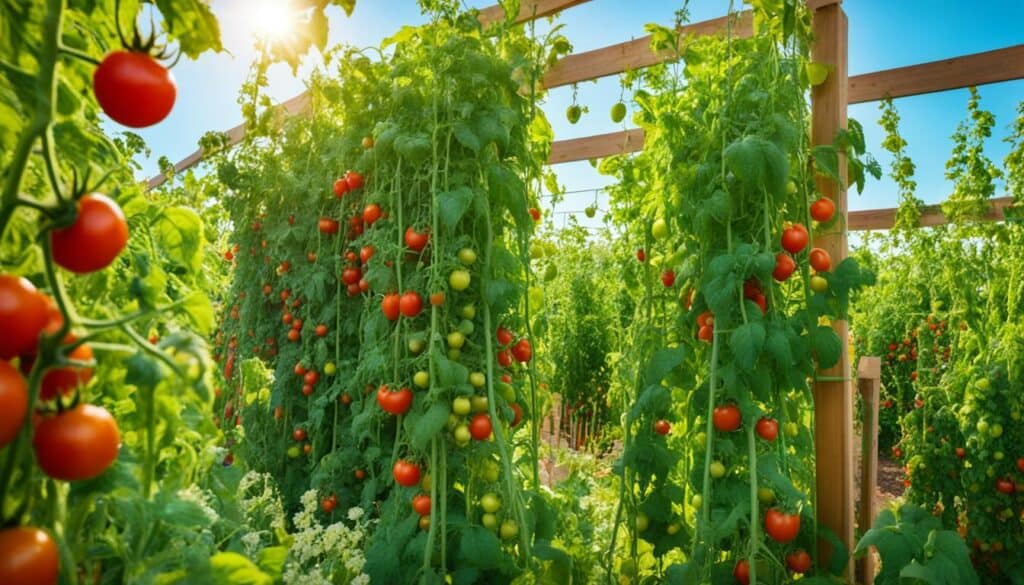



Leave a Reply